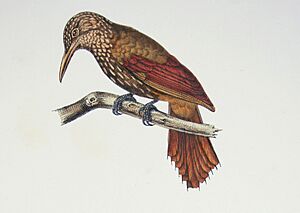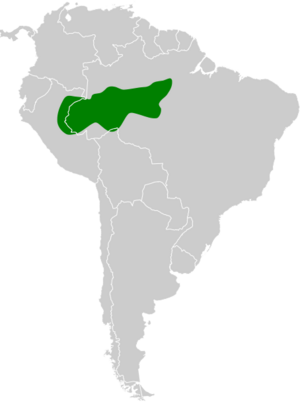Ocellated woodcreeper facts for kids
Quick facts for kids Ocellated woodcreeper |
|
|---|---|
 |
|
| Conservation status | |
| Scientific classification | |
| Genus: |
Xiphorhynchus
|
| Species: |
ocellatus
|
 |
|
| Range of ocellated woodcreeper sensu stricto; see Taxonomy and Status sections | |
The ocellated woodcreeper (Xiphorhynchus ocellatus) is a cool bird that lives in the forests of South America. It's part of the ovenbird family, which is known for building interesting nests. You can find this bird in countries like Bolivia, Brazil, Colombia, Ecuador, Peru, and Venezuela.
Contents
Understanding the Ocellated Woodcreeper
How Scientists Classify This Bird
Sometimes, scientists don't always agree on how to classify animals, and the ocellated woodcreeper is one of those cases! Most groups, like the South American Classification Committee (SACC) and the Clements taxonomy, see it as one species with seven different types, called subspecies. Think of subspecies as different "versions" of the same animal that might look a little different or live in different areas.
Another group, the International Ornithological Committee (IOC), used to think some of these types were a separate species called Tschudi's woodcreeper. But in 2023, they decided to group them all together again.
This article follows the idea that it's one species with seven subspecies. Here are some of the subspecies:
- X. o. lineatocapilla
- X. o. beauperthuysii
- X. o. perplexus
- X. o. ocellatus (This is the main type, often called the "nominate subspecies")
- X. o. napensis
- X. o. chunchotambo
- X. o. brevirostris
However, another important bird guide, the Handbook of the Birds of the World (HBW), still sees things differently. They consider some of these types as separate species. It just goes to show that science is always learning and changing!
What Does the Ocellated Woodcreeper Look Like?
This bird is about 20 to 24.5 centimeters (8 to 9.6 inches) long, which is about the size of a large robin. It weighs between 24 and 42 grams (0.8 to 1.5 ounces). It's a slender, medium-sized woodcreeper with a long, almost straight beak. Male and female ocellated woodcreepers look very similar.
The most common type, X. o. ocellatus, has a dark brown head and neck with fine, light brown streaks. Its back is a plain reddish-brown, while its wings and tail are a brighter cinnamon-red. Its throat is a deep buff color. The chest has large, buff-colored "teardrop" spots with faint darker edges. Its belly is mostly plain. Its eyes are dark brown, its beak is blackish with a pale gray lower part, and its legs and feet are gray. Young birds look a lot like adults but have more noticeable markings on their undersides.
Other subspecies have slight differences:
- X. o. lineatocapilla: Has a heavier beak and a darker head.
- X. o. perplexus: Its rump, wings, and tail are a darker reddish color.
- X. o. chunchotambo: Has a blackish-brown head with small buff "teardrops" and thin streaks on its back.
Where Do They Live?
The ocellated woodcreeper lives in different parts of the Amazon rainforest and nearby areas. Each subspecies tends to live in its own specific region:
- X. o. lineatocapilla: Found along the Rio Orinoco in southern Venezuela.
- X. o. beauperthuysii: Lives in northwestern Amazonia, including parts of Colombia, Venezuela, Peru, and Brazil.
- X. o. perplexus: Found in western Amazonia, south of the Amazon River, in Peru, Brazil, and Bolivia.
- X. o. ocellatus: Lives in Amazonian Brazil, between the Rio Purus and Rio Tapajós.
- X. o. napensis: Found on the lower slopes of the Andes mountains and nearby western Amazonia, from Colombia through Ecuador to Peru.
- X. o. chunchotambo: Lives on the lower Andean slopes of northeastern and eastern Peru.
- X. o. brevirostris: Found in the foothills of the Andes and nearby Amazonia in southeastern Peru, Bolivia, and Brazil.
These birds mostly live in evergreen forests. Many of them prefer "terra firme" forests, which are forests on higher ground that don't flood. They can also be found in "várzea" forests (which flood seasonally) and wooded swamps. Some subspecies, especially those in the Andes, prefer mountain forests and "cloudforests" (forests often covered in clouds). They like the inside of old, mature forests but can also be seen at the edges or in younger, regrowing forests. They usually live below 500 meters (1,600 feet) in elevation, but some can be found as high as 1,800 meters (5,900 feet) in the Andes.
Ocellated Woodcreeper Behavior
Movement
The ocellated woodcreeper stays in the same area all year round. It doesn't migrate to different places.
Feeding Habits
Scientists don't know everything about what the ocellated woodcreeper eats, but they believe it mainly eats arthropods, which are creatures like insects and spiders. These birds often join groups of different bird species that are foraging together. Sometimes, they even follow swarms of army ants, catching insects that the ants stir up.
The woodcreeper moves by hopping up tree trunks and along branches, usually from the lower parts of the forest up to the middle layers. It finds most of its food by picking and probing the bark of trees. It also sometimes probes into plants that grow on trees, like epiphytes.
Reproduction and Life Cycle
Sadly, very little is known about how the ocellated woodcreeper breeds or raises its young. Scientists are still hoping to learn more about this part of their lives!
What Does the Ocellated Woodcreeper Sound Like?
The ocellated woodcreeper sings mostly at dawn and dusk, but usually only a few songs at a time. Its song changes depending on where the bird lives. For example:
- In eastern Ecuador, it sounds like a fast series of nasal notes, "whe-whe-whe-whe-whe-chéchécheow."
- In much of Brazil, it's a short, fast, descending, rattling sound.
- In Peru, it's a quiet, accelerating series of notes, like "hee-ee-ee-i’i’i’i’i’i’ chee’ee’ee tree’ee’ee tree’ee’ee."
The bird also makes many different calls besides its song.
Conservation Status
The International Union for Conservation of Nature (IUCN) assesses the ocellated woodcreeper's conservation status. They follow the HBW's classification, meaning they look at the "ocellated," "line-crowned," and "Tschudi's" woodcreepers separately.
Good news! All three are currently listed as "Least Concern." This means they are not in immediate danger of extinction. They live in very large areas, but their exact population numbers aren't known, and scientists believe their populations might be slowly decreasing. No major threats have been found for them right now. The species seems to be fairly common in most places it lives, but it is thought to be very sensitive to losing its forest home or when forests become broken up into smaller pieces.


